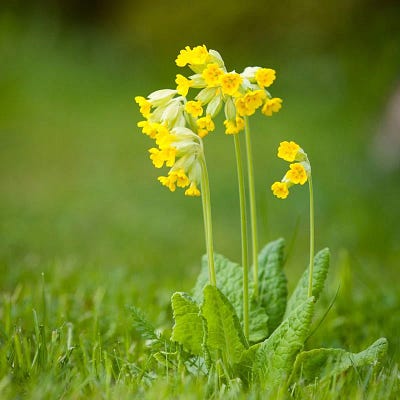The app for independent voices
Flower notes: March
The cowslips are out:
In my garden and out in the meadows, the cowslip’s tiny stems are rising sturdily and proudly out of the winter mud. Spring is here when the cowslips come.
‘COWSLIP’. The word sounds so dainty, so delicate, doesn’t it? But as Geoffrey Grigson says in his ‘Englishman’s Flora’:
Cowslip is not the most elegant of names. It is a polite form of Cowslop, in Old English cu-sloppe, cu-slyppe - 'cow dung' or 'cow pat', obviously from a conception that the cowslip sprang up in the meadow wherever a cow had lifted its tail 😳
Cowslop or no, the deliciously coloured and deliciously scented flowers make the best and most delicate of all country wines.
I’m loving these regional names – maybe I’ll start calling cowslips Tisty Tosties or Fairies Basins from now on….
Local names for cowslips include:
BUNCH OF KEYS, Somerset; COVE-KEYS, Kent; COWFLOP, Devon, Somerset; COW PAIGLE, Hertfordshire; CARSLOPE, Yorkshire; COOSLOP, Lincolnshire; COWER-SLOP, Shropshire; COWSLAP, Hertfordshire, Northamptonshire; COWSLOP, Devon, East Anglia, Northamptonshire, Shropshire, Cheshire; COWSLUP, Warwickshire, Worcestershire; cow's MOUTH, Lothian; COW STRIPPLING, COW STROPPLE, COW STRUPPLE, Yorkshire, Cumbria, West, North England; CREIVEL, Dorset; CREWEL, Devon, Dorset, Somerset, Wiltshire; Cuckoo(coucou is also a French name), Cornwall; CULVERKEYS, Somerset, Kent, Northamptonshire; FAIRIES' BASINS, Somerset; FAIRIES' FLOWER, Somerset; FAIRY BELLS, Somerset; FAIRY CUPS, Dorset, Somerset, Lincolnshire; FRECKLED FACE, Somerset. GOLDEN DROPS, Somerset; HERB PETER, Somerset, Cheshire; HODROD, Dorset; HOLROD, Dorset; HORSE BUCKLE, Wiltshire, Kent; KEYS OF HEAVEN (cf. German Himmel-schlüssel), Devon; LADY'S BUNCH OF KEYS, Somerset; LADY'S FINGERS, Scotland; LADY'S KEYS, Somerset, Wiltshire, Kent; LONG LEGS, Somerset; MILK-MAIDENS, Lincolnshire; ODDROD, Dorset; PAIGLE, Dorset, Kent, Middlesex, Hertfordshire, East Anglia, Bedfordshire, Northamptonshire, Cheshire, Lincolnshire, Yorkshire, N Eng, Pemb; RACCONALS, Ches; ST PETER'S HERB, Yorkshire; ST PETER'S KEYS, Somerset: TISTY-TOSTY (properly a cowslip ball), Devon, Dorset, Somerset, Wiltshire, Gloucestershire, Herefordshire; ROSTY (properly a cowslip ball), Somerset, Wiltshire, Gloucestershire, Worcestershire, Pembrokeshire. Welsh names include dagrau Mair, 'Mary's tears'
‘The Herball’ printed by Richard Banckes in 1525 called it 'cousloppe' or Herba Petri. ‘The Grete Herball ‘ of 1526 called it Cowslyp, Pagle, Saynt Peterworte, and Herbe Paralysy. Gerard knew it also as Palsywort. The medieval ‘Regimen Sanitatis Salernitanum’ had commended the Cowslip as a cure for palsy or paralysis, a cure suggested perhaps by the trembling or nodding of the flowers.
'Primrose' (i.e.Primula veris) and lavender boiled together in ale were advised 'for trembelynge hand and handis a slepe' in a manuscript of the fifteenth century. The nodding flowers also suggested the bunch of keys which were the badge of St Peter. One legend of northern Europe is that Peter let his keys drop when he was told that a duplicate key to Heaven had been made. Where the keys fell, the Cowslip broke from the ground.

